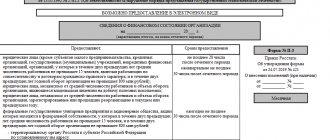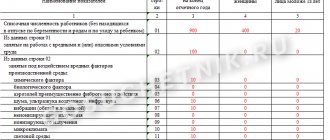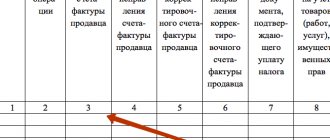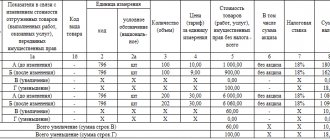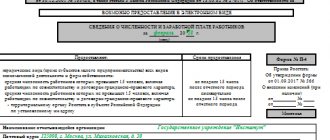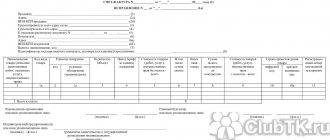Home → Articles → Filling out invoices from October 2017
As of October 1, 2017, the rules for filling out invoices have changed. How justified are the requirements of some counterparties to indicate the following things when issuing invoices to them: 1. The names of the Seller and the Buyer in the invoice must fully comply with the Unified State Register of Legal Entities, which means that both names must be written in large letters, as in the Unified State Register of Legal Entities; 2. The names of the Seller and the Buyer in the invoice must be written in full, as in the Unified State Register of Legal Entities, that is, not LLC “XXX”, but Limited Liability Company “XXX”; 3. How should line (8) “Identifier of the government contract, agreement (agreement)” be filled in if a government contract has been concluded with the client and if the agreement is commercial? Some counterparties require filling out this line in the form “Identifier of the state contract, agreement (agreement) (if any): …”, and then either empty for a commercial agreement, or details of the State Contract. How mandatory is the phrase “(if available)”?
An invoice is a document that serves as the basis for the buyer to accept the goods (works, services), property rights presented by the seller of tax amounts for deduction in the manner prescribed by Chapter 21 of the Tax Code of the Russian Federation (clause 1 of Article 169, clause 1 of Article 172 of the Tax Code of the Russian Federation ).
Requirements for issuing invoices are set out in paragraphs. 5, 5.1 and 6 tbsp. 169 of the Tax Code of the Russian Federation, for adjustment invoices - in clauses 5.2 and 6 of Art. 169 of the Tax Code of the Russian Federation.
If the invoices do not meet the requirements listed in clauses. 5, 5.1 and 6 tbsp. 169 of the Tax Code of the Russian Federation, and adjustment invoices - to the requirements listed in clauses 5.2 and 6 of Art. 169 of the Tax Code of the Russian Federation, then no VAT deduction is provided for such invoices (paragraph 3 of clause 2 of Article 169 of the Tax Code of the Russian Federation).
However, errors in invoices and adjustment invoices do not prevent the tax authorities from identifying the seller, buyer of goods (work, services), property rights, the name of goods (work, services), property rights, their value, as well as the tax rate and the amount of tax presented to the buyer are not grounds for refusing to accept tax amounts for deduction (paragraph 2, clause 2, article 169 of the Tax Code of the Russian Federation).
The mandatory details of an invoice (adjustment invoice) from July 1, 2021 (after the entry into force of Federal Law No. 56-FZ dated April 3, 2017), in particular, include: – name and address of the taxpayer and buyer (clauses 2 clause 5, clause 2 clause 5.1, clause 3 clause 5.2 of Article 169 of the Tax Code of the Russian Federation); – identifier of the state contract, agreement (agreement) (if any) (clause 6.2 clause 5, clause 4.2 p 5.1, clause 6.1, clause 5.2 of Article 169 of the Tax Code of the Russian Federation).
Note that the provisions of Art. 169 of the Tax Code of the Russian Federation, as well as other provisions of the Tax Code of the Russian Federation, do not decipher such concepts as “name” and “address” of the taxpayer and buyer, as well as “state contract identifier”, and do not establish the order of their writing in invoices.
Clause 8 of Art. 169 of the Tax Code of the Russian Federation establishes that the form of the invoice and the procedure for filling it out, the forms and procedure for maintaining a log of received and issued invoices, purchase books and sales books are established by the Government of the Russian Federation.
In pursuance of this norm, Resolution of the Government of the Russian Federation dated December 26, 2011 No. 1137 “On the forms and rules for filling out (maintaining) documents used in VAT calculations” (hereinafter referred to as Resolution No. 1137) was adopted and is in force. A number of amendments were made to Decree No. 1137 by Decree of the Government of the Russian Federation dated August 19, 2017 No. 981, which entered into force on October 1, 2017, as well as by Decree of the Government of the Russian Federation dated May 25, 2017 No. 625, which entered into force on July 1, 2017.
In particular, the changes affected the procedure for filling out lines 2a “Address” and 6a “Address” of the invoice. So, on the basis of paragraphs. “d”, “k” clause 1 of the Rules for filling out an invoice used in VAT calculations approved by Resolution No. 1137 (hereinafter referred to as the Rules), from 10/01/2017 on these lines must be indicated (see also the letter of the Ministry of Finance of Russia dated 11/10/2017 .2016 No. 03-07-14/65748): – for legal entities – the address indicated in the Unified State Register of Legal Entities (hereinafter referred to as the Unified State Register of Legal Entities), within the location of the legal entity; – for individual entrepreneurs – place of residence indicated in the Unified State Register of Individual Entrepreneurs (hereinafter referred to as the Unified State Register of Individual Entrepreneurs).
Based on paragraphs. “n” clause 1 of the Rules from 01.07.2017 in line 8 of the invoice it is necessary to indicate the identifier of the state contract for the supply of goods (performance of work, provision of services), agreement (agreement) on the provision of subsidies, budget investments, contributions from the federal budget to a legal entity to the authorized capital (if any).
At the same time, the general procedure for writing the names of the taxpayer and the buyer on invoices (lines 2 and 6 of the invoice) has not changed either from 10/01/2017 or from 07/01/2017. According to paragraphs. “c”, “and” clause 1 of the Rules in these lines for legal entities indicate the full or abbreviated name in accordance with the constituent documents (as before). These provisions do not contain references to the Unified State Register of Legal Entities.
Next, we will consider in detail the procedure for filling out the invoice details we mentioned.
What are invoices for: basic knowledge
An invoice is a documentary basis for the buyer to accept the VAT amounts presented by the seller for deduction (refund). This follows from paragraph 1 of Article 169 of the Tax Code of the Russian Federation. Tax legislation requires an invoice to be issued every time you sell goods, work, services or property rights. Invoices can be generated on paper or electronically. The paper form and the rules for filling it out are defined in Appendix No. 1 to Decree of the Government of the Russian Federation of December 26, 2011 No. 1137.
Decree of the Government of the Russian Federation dated December 26, 2011 No. 1137 approved the current forms and Rules for filling out (maintaining) the following documents used in VAT calculations:
- invoices (Appendix No. 1);
- adjustment invoice (Appendix No. 2);
- log of received and issued invoices (Appendix No. 3);
- purchase books (Appendix No. 4);
- sales books (Appendix No. 5).
If the seller wishes to send invoices to buyers electronically, the buyer is required to agree to this. At the same time, the means of receiving, exchanging and processing invoices electronically between the seller and the buyer must be compatible. They must comply with the established formats (paragraph 2, paragraph 1, article 169 of the Tax Code of the Russian Federation). Invoices are issued and received electronically in the manner approved by Order of the Ministry of Finance of Russia dated November 10, 2015 No. 174n.
Basic moments
In fact, this is the most important accounting document related to primary documentation. Incorrect registration of the SF can lead to problems with the Tax authorities and refusal to receive a VAT deduction.
Owners of large and small businesses know the importance of this paper. And what consequences can result from inattention to the preparation of invoices?
Dear readers! The article talks about typical ways to resolve legal issues, but each case is individual. If you want to find out how to solve your particular problem , contact a consultant:
8 (800) 700 95 53
APPLICATIONS AND CALLS ARE ACCEPTED 24/7 and 7 days a week.
It's fast and FREE !
What it is
An invoice is a document that is issued when funds are received from the buyer's account to the supplier's account. This paper is used in the work of legal entities.
Photo: Invoice
It is necessary for:
- Confirmation of receipt of funds.
- Fixing the purchase and sale transaction.
- Confirmation of the tax amount.
In other words, when selling products, you are required to reflect all the data on the invoice. The document is issued in two copies, one of which is handed over to the buyer, while the other remains at the enterprise. It refers to primary accounting documentation and is necessary not only for recording cash transactions on sales, but also for maintaining management accounting.
When registering, please indicate:
- name of the product or service;
- quantity of goods and its symbol;
- individual code for each type of product;
- cost of goods excluding tax;
- total cost of delivery including VAT;
- cost per unit of goods with and without tax.
There is a single form for filling out invoices, approved at the legislative level. Any deviations from the registration norm may lead to loss of funds, since such a document may be declared invalid.
An invoice can be submitted in two forms - electronic and paper. It also has two types:
| Indicators | Description |
| Standard | issued in cases of full payment for a delivery or service |
| Advance | issued in cases of partial payment. It does not indicate standard data - name, number of units and price, information about the recipient and sender |
What is regulated
According to Article 169 of the Tax Code of the Russian Federation, any legal entity is obliged to keep a book of sales and purchases with all available invoices attached.
Article 168 of the Tax Code of the Russian Federation contains basic information about the timing of document execution. For example, when selling goods or services, an enterprise is obliged to provide an invoice no later than five working days inclusive.
All supply transactions are regulated by Federal Law and the Tax Code of the Russian Federation.
Another change to the invoice form
The last time the invoice form changed was relatively recently - from July 1, 2021. By Decree of the Government of the Russian Federation dated May 25, 2017 No. 625, changes were made to the forms of invoices and adjustment invoices. From July 1, 2021, the invoice form was supplemented with line 8 “Identifier of the government contract, agreement (agreement).” The adjustment invoice, in turn, was supplemented with a new line 5 with the same name. We talked about this in detail in the article “Invoice from July 1, 2021: new form and format.”
As of October 1, 2021, the invoice form has changed again. Now the amendments are provided for by Decree of the Government of the Russian Federation dated August 19, 2017 No. 981. You can download this document from the link.
What exactly has changed in the invoice form?
Now we will tell you in detail about the changes in the invoice from October 1, 2021. We have highlighted the main ones.
Added a new column “Product type code”
From October 1, 2021, a new column 1a “Product Type Code” appeared in the invoice form. It must be filled out by organizations exporting goods outside the Russian Federation to the countries of the EAEU. The product type code will need to be indicated in accordance with the unified Commodity Nomenclature for Foreign Economic Activity of the EAEU.
The code of the type of goods according to the foreign economic activity product nomenclature was required to be shown in invoices before October 1 (subclause 15, clause 5, article 169 of the Tax Code of the Russian Federation). However, there was no special column for this before, so the product code was usually indicated in column 1 - after the name of the goods.
Please note that if there is no data in the new column “Product Type Code”, a dash will be added from October 1, 2021.
Provided a signature field for an authorized person
From October 1, 2021, a new column for the signature of the authorized person signing the invoice for the entrepreneur has appeared in the invoice form. Previously, such columns were in the invoice exclusively for the signatures of persons who sign for the manager or chief accountant.
If the signatures on the invoice are put by authorized persons, then the transfer of authority must be formalized by an order of the manager or a power of attorney on behalf of the organization. As for an individual entrepreneur, the person authorized by him has the right to sign documents only on the basis of a power of attorney certified by a notary.
The name of column 11 has been clarified
Previously, column 11 in the invoice was called “Customs Declaration Number”. However, as of October 1, 2021, the name of this column has been clarified. Now it is called “Customs Declaration Registration Number”. That is, in column 11, instead of the customs declaration number, its registration number should now be given. Let us remind you that these are different numbers.
The customs declaration registration number and the customs declaration number are different. This follows from the joint Order of the State Customs Committee of the Russian Federation No. 543, the Ministry of Taxation of the Russian Federation No. BG-3-11/240 dated June 23, 2000.
Column 8 was brought into compliance with the rules
As we have already said, from July 1, 2021, column 8 appeared in the invoice form, in which you need to indicate the identifier of the government contract. From October 1, 2021, line 8 will contain a clarification about the need to fill it out if you have a government contract identifier. This is a technical change, because the rules for filling out an invoice already provide for this.
You can download the new Word invoice form for free, effective October 1, 2021, from this link.
You can also create a new invoice form in Excel format.
Let's give a sample of filling out the new invoice form from 10/01/2017 using a specific example.
Situation
"Arma-2" produces office furniture. On October 4, 2021, Arma-2 shipped 25 Gradiolus furniture sets to Belarus. Buyer: Belarusian Sour Cream Factory. The selling price of one headset is 150,000 rubles. (VAT rate – 0%). The total transaction amount is RUB 3,750,000. (25 pcs. × RUB 150,000/pcs.).
The organization sold furniture sets for export. Therefore, the VAT rate is 0 percent.
Arma-2 presented the buyer with an invoice for the cost of the shipped products. In column 1a “Product type code”, the accountant indicated the product code according to the EAEU Commodity Nomenclature for Foreign Economic Activity – “940330 190 0”. In column 11 “Registration number of the customs declaration” we will mark a dash (since the Russian goods are being sold).
You can fill out a sample of the new invoice form from October 1, 2021 under these conditions.
What data is indicated - legal or factual?
The address indicated in the Unified State Register of Legal Entities (for legal entities) and in the Unified State Register of Individual Entrepreneurs (for individual entrepreneurs) must be indicated in full, including the number of the house, office, room.
The main requirement of modern tax legislation regarding addresses entered in lines 2a and 6a of the invoice is that they must coincide with the address recorded in the Unified State Register of Legal Entities/Unified State Register of Individual Entrepreneurs. The extract from the Unified State Register of Legal Entities contains information about the location of the organization according to the registration documents (clause 2 of Article 54 No. 51-FZ of November 30, 1994, as amended on December 29, 2017).
For individual entrepreneurs, the address in the Unified State Register of Individual Entrepreneurs is the location of the individual, otherwise the place of registration. To verify the correctness of the information reflected in lines 2a and 6a, the organization can, without additional requests to the partner, check the information from the Unified State Register of Legal Entities/Unified State Register of Individual Entrepreneurs with the data in the invoice.
Today, anyone, both an individual and a legal association, can get access to extracts from the Unified State Register of Legal Entities of registered taxpayers. Invoices issued after October 1, 217 must indicate the address of the location of the permanent executive body, i.e. legal address.
How the filling rules have changed
In addition to the actual form of the invoice form, from October 1, 2017, the rules for filling out this document have also changed. There are quite a few amendments in this part. Let's list the most important ones.
The seller's address must be indicated in accordance with the Unified State Register of Legal Entities or Unified State Register of Entrepreneurs
As of October 1, 2017, changes have been made to the procedure for filling out line 2a of the invoice. Currently, this line indicates the location of the seller-organization in accordance with the constituent documents or the place of residence of the seller-individual entrepreneur. From 01.10.17, in line 2a it will be necessary to indicate the address of legal entities specified in the Unified State Register of Legal Entities, or the place of residence of an individual entrepreneur indicated in the Unified State Register of Legal Entities. You can check the address in the register on the official website of the Federal Tax Service using a special service. Here is the link. Also see “Exclusion of legal entities from the Unified State Register of Legal Entities from September 1, 2021.”
Even before October 1, 2021, we recommend that the invoice reflect the postal code, name and type of subject of the Russian Federation, name of the locality, street, house number, building, building. This data should be entered for both the buyer and the seller.
Rules for forwarders have appeared
From October 1, 2021, the procedure for filling out an invoice has been supplemented with new provisions. They are used in cases where the invoice is drawn up by a freight forwarder, a developer or a customer performing the functions of a developer when purchasing property rights from one or more sellers of goods (works, services) on its own behalf.
So, in particular, from October 1, 2021, the procedure for drawing up invoices for forwarders who organize transportation using third-party companies was prescribed. Before this there were no rules for them. Therefore, forwarders filled out invoices according to the rules established for commission agents (letter of the Ministry of Finance of Russia dated January 10, 2013 No. 03-07-09/01).
A freight forwarder who organizes transportation using third-party carriers has the right to prepare “consolidated” invoices. In them, he reflects the data of invoices received from performing carriers. According to the new rules, from October 1, 2021, a freight forwarder who makes purchases on its own behalf at the client’s expense will have to indicate in “consolidated” invoices:
- in line 1 - the date and number of the “consolidated” invoice according to the chronology of the forwarder;
- in line 2 - full or abbreviated name of the seller (forwarder), full name of the entrepreneur (forwarder);
- in line 2a – the forwarder’s address;
- in line 2b - INN and KPP of the seller (forwarder);
- in line 5 - details (number and date of preparation) of payment and settlement documents indicating that the forwarder transferred money to the sellers, and the client - to the forwarder - through the sign “;”;
- in column 1 - names of goods (works, services) in separate positions for each seller;
- in columns 2–10 - for each seller, data from the invoices they issued to the forwarder.
From October 1, 2021, freight forwarders can issue consolidated invoices. In the consolidated invoice, in the lines “Seller”, “Address”, “TIN/KPP” of the seller, you can indicate your own data. That is, the data of the forwarder, and not of third parties providing services to the forwarder.
The price is determined by calculation: how to fill out an invoice
Sometimes accountants were faced with the question of how to fill out invoices if the contract price was determined by calculation. This question is relevant when the price of a product (work, service) is the difference between the cost including VAT and the amount of VAT. The Rules for filling out an invoice from October 1, 2021 explain that in these cases, column 4 of the invoice is the difference between columns 9 and 8. Use this approach to filling out column 4 if:
- property was sold that was taken into account during the purchase, including VAT (clause 3 of Article 154 of the Tax Code of the Russian Federation);
- sold agricultural products purchased from individuals (clause 4 of article 154 of the Tax Code of the Russian Federation);
- sold cars previously purchased from individuals (clause 5.1 of Article 154 of the Tax Code of the Russian Federation);
- transferred property rights (clauses 1–4 of Article 155 of the Tax Code of the Russian Federation).
Indication of the address in the employment contract
The employment contract must indicate the address of the organization from the Unified State Register of Legal Entities. For example, if a seller works at any retail outlet of the company, then it is necessary to indicate not only the address from the Unified State Register of Legal Entities, but also the location where this point is located.
If the case concerns an employee who is traveling, then in such a situation it is necessary to indicate not only the office address from the Unified State Register of Legal Entities, but also the office address (if it is different). Here it will be necessary to add that the employee’s work is carried out at the addresses specified by the employer.
How the form of the adjustment invoice has changed
The Tax Code of the Russian Federation establishes the obligation to issue adjustment invoices (paragraph 3, clause 3, Article 168 of the Tax Code of the Russian Federation). Sellers of goods (works, services) exhibit them in the event of an adjustment to the cost of shipped goods (work performed, services rendered) or transferred property rights. This can happen when, for example, the price or quantity (volume) of goods (work, services), property rights changes.
From October 1, 2021, column 1b for the product type code was added to the adjustment invoice form. It will be filled out by organizations that export goods to the EAEU countries.
Also, from this date, additional lines and columns were officially allowed to be added to the adjustment invoice (in particular, details of the primary invoice). However, the basic form of the adjustment invoice must remain the same.
a new form for an adjustment invoice from October 1, 2017 in Word format.
a new form for an adjustment invoice from October 1, 2017 in Excel format.
New rules for storing invoices
From October 1, 2021, the rules for storing invoices will be clearly established. It will be necessary to store them in chronological order as they are exhibited (compiled, corrected) or received. A similar storage approach will apply to electronic document management operator confirmations and notifications to customers of receipt of invoices. All types of invoices (initial adjustment and corrected) will need to be kept for four years. Copies of paper invoices received from intermediaries must be certified by their signatures (principals, principals, developers or forwarders).
Read also
30.05.2017

